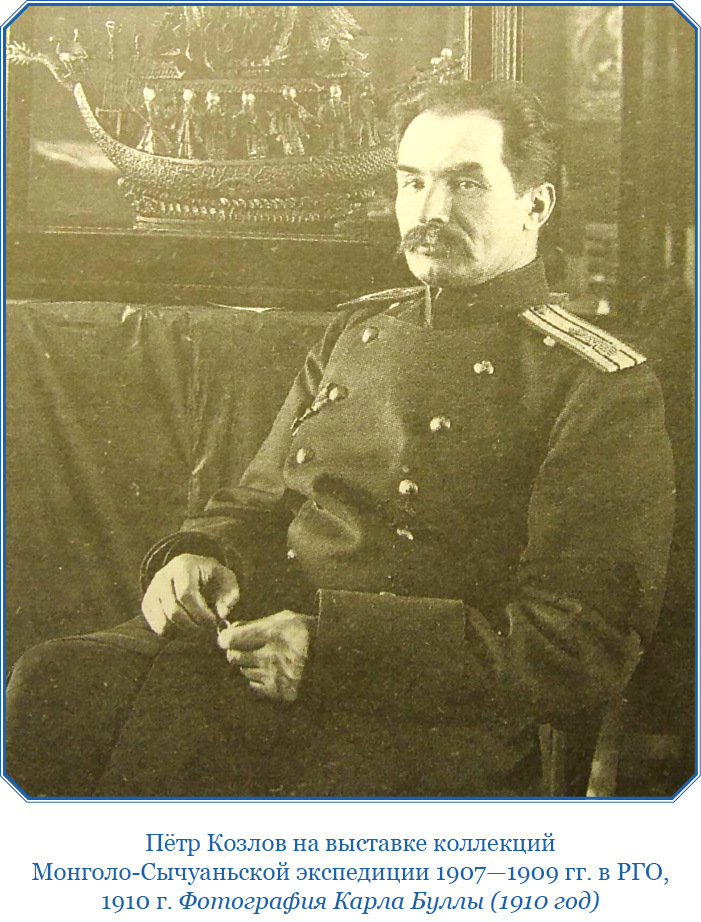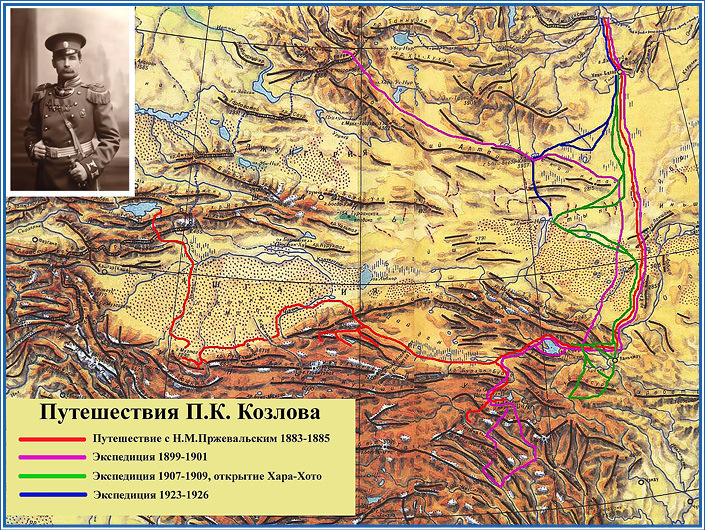For me, there is no better life than when traveling.
P. K. Kozlov
AT The outstanding traveler Pyotr Kuzmich Kozlov (1863–1935) belongs to the brilliant constellation of travelers and explorers of Central Asia in the second half of the 19th and early 20th centuries. A student and follower of N. M. Przhevalsky, he devoted his entire life to the scientific development of the vast territories of the Asian continent, little studied or completely unknown to the geographical science of that time.
P. K. Kozlov was born into a poor semi-literate family in the city of Dukhovshchina in the Smolensk region. After graduating from the city's six-year school, he was going to enter the Vilna Teacher's Institute, but the teachers (among whom was the famous educator V.P. Vakhterov in the future) could not get him a state scholarship. Peter Kozlov had to get a job in the office of a local distillery in the village of Sloboda (now the city of Przhevalsk, Smolensk region). A chance meeting with N. M. Przhevalsky in 1882 in Sloboda, where the estate of the famous traveler was located, drastically changed the life of a village youth.
N. M. Przhevalsky saw a kindred spirit in young Pyotr Kozlov and offered to participate in his IV Central Asian (II Tibetan) expedition. To do this, Kozlov had to pass an exam for the course of the Smolensk real school and enter the army as a volunteer, since N. M. Przhevalsky completed his expeditions exclusively from military personnel. “Przhevalsky was my great father: he brought up, taught and led the general and private preparation for the trip,” Kozlov later recalled. Under the direct guidance of N. M. Przhevalsky, the young man acquired the knowledge and practical skills necessary for distant wanderings, in particular, he learned the art of preparator. Later, working alongside N. M. Przhevalsky, P. K. Kozlov formed himself as a professional traveler-researcher, mastered his extensively descriptive method of “route reconnaissance” and successfully used it in his research activities.
“From this two-year, first trip for me, I returned a different person - Central Asia became my goal of life,” Kozlov wrote in a brief biographical essay. “This conviction did not waver, on the contrary, it became even stronger after severe moral suffering associated with the unexpected death of my unforgettable teacher […]”. The bright image of N. M. Przhevalsky - Psheva - inspired Kozlov all his life.
Another teacher and patron of Kozlov for many years was the famous geographer-traveler, vice-chairman of the Imperial Russian Geographical Society P.P. Semenov-Tian-Shansky, who greatly contributed to his expeditionary activities after the death of N.M. Przhevalsky.
From 1883 to 1926 P.K. Kozlov made six large expeditions to Mongolia, Western and Northern China and Eastern Tibet, three of which he personally led. His talent as a traveler-naturalist manifested itself especially clearly during the first independent Mongol-Kama expedition of 1899–1901. Her scientific results exceeded all expectations - Kozlov brought to St. Petersburg a huge and unusually diverse collection of natural history, interesting ethnographic information about the nomadic tribes of Tibet, and valuable data on the zoogeography of completely unexplored regions of Central Asia. As a result of this expedition, which covered more than 10,000 km with surveys, the largest ridges in Eastern and Central Tibet were mapped (the ridge of the Russian Geographical Society, the Watershed ridge (the Huang He and Yangtze basins), the Rockhill ridge, etc.). Kozlov's research was highly appreciated by the world scientific community. The IRGS, which equipped the expedition, awarded the traveler for his outstanding contribution to the study of Central Asia with its highest award - the Konstantinovsky gold medal.
Kozlov's next expedition, the Mongol-Sichuan expedition (1907–1909), glorified him with unique archaeological finds made during excavations of the "dead" city of Khara-Khoto on the river. Edzin-gol, in the sands of the southern Gobi. In one of the religious buildings - the reliquary suburgan, called "famous", P.K. Kozlov was lucky to find a rich collection containing thousands of books and manuscripts in the Tangut, Chinese, Tibetan and Uighur languages, hundreds of sculptures and icons, shrines from Buddhist temples etc. Materials from the "famous" suburgan allowed scientists to restore the history of the forgotten Tangut state Xi-Xia, which existed for about 250 years (982-1227) on the territory of modern northern China.
The discovery and sensational excavations of Khara-Khoto received a great response in the scientific world, which brought Kozlov the highest awards of the Italian and London Geographical Societies, the Prize. P. A. Chikhachev of the French Academy of Sciences, and the Imperial Russian Geographical Society and the Hungarian Geographical Society elected him an honorary member, respectively, in 1910 and 1911.

Another important event in Kozlov's life of this period was his acquaintance with the spiritual and secular ruler of Tibet, the 13th Dalai Lama. Their first meeting took place in 1905 in the capital of Outer Mongolia, Urga, where the Dalai Lama was forced to flee because of the British invasion of Tibet. Captain Kozlov greeted the Tibetan high priest and presented him with gifts on behalf of the Russian Geographical Society for the hospitality shown to the Mongol-Kama expedition in 1899-1901, and also, on behalf of the Ministry of Foreign Affairs and the General Staff, discussed the possibility of Russia providing assistance to Tibet. Kozlov's meeting with the Dalai Lama, which took place at such a dramatic moment for Tibet, marked the beginning of their warm friendly relations that lasted for many years.
In 1909, the traveler paid a new visit to the ruler of Tibet - this time in the Buddhist monastery of Gumbum (in the province of Amdo, in Eastern Tibet). Establishing close relations with the Dalai Lama and his associates was not only of great political importance, from the point of view of strengthening Russian-Tibetan ties, but was also very useful on a personal level, since it opened the door to Lhasa, which was forbidden to Europeans, for an inquisitive researcher.
Kozlov tried to take advantage of this circumstance in 1914, starting preparations for a new big trip. The expedition was designed as a Mongolian-Tibetan one. Its purpose was to be an additional study of the ruins of Khara-Khoto and the study of the Tibetan Plateau, mainly the basins of the upper reaches of the three great rivers of Asia: the Yangtze, the Mekong and the Salween. At the same time, Kozlov secretly hoped that he would finally be able to fulfill his and his teacher's cherished dream - to visit Lhasa. But the world war unexpectedly intervened in his plans. As a result, Colonel of the General Staff P.K. Kozlov went to the Southwestern Front, where for some time he served as commandant of the cities of Tarnov and Iasi. And then in 1915 he was sent to Mongolia at the head of a special government expedition ("Mongolex"), which was engaged in the purchase of livestock for the needs of the army.

Kozlov took the October Revolution ambiguously, but did not refuse to cooperate with the Bolsheviks. Not the last role in this was played by his being in demand by the new government. Already in November 1917, the Russian Academy of Sciences appointed Kozlov a commissioner to the famous Crimean acclimatization zoo-reserve Askania-Nova. This appointment was not accidental: well acquainted with the zoo itself and its founder F. E. Falz-Fein, even before the war, Kozlov energetically advocated the speedy nationalization of this unique corner of nature. And in the new political conditions, he continued the struggle to save the zoo from plunder and destruction, which resulted in the decree of the government of Soviet Ukraine on the "saving" of Askania-Nova in April 1919.
